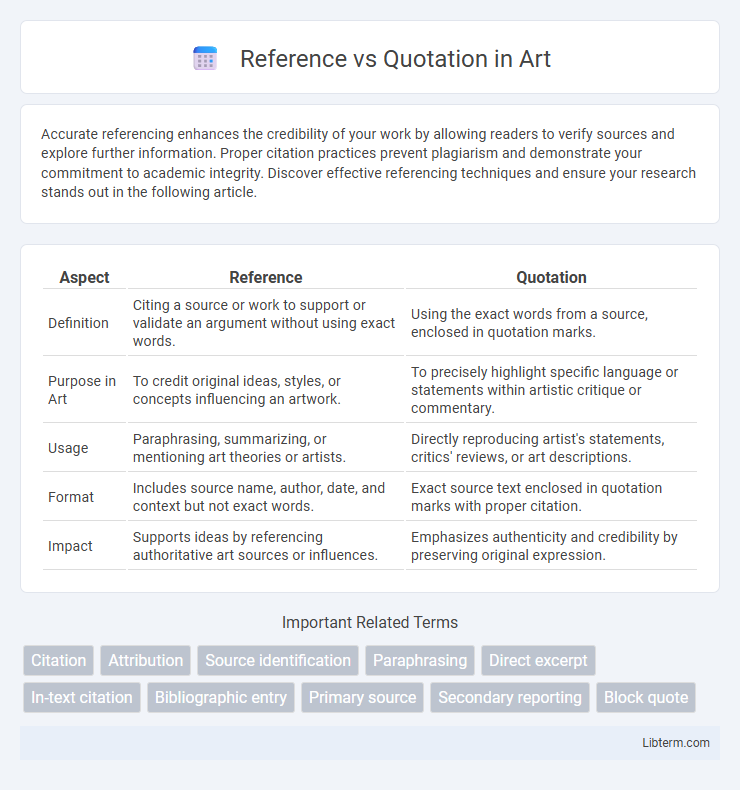Accurate referencing enhances the credibility of your work by allowing readers to verify sources and explore further information. Proper citation practices prevent plagiarism and demonstrate your commitment to academic integrity. Discover effective referencing techniques and ensure your research stands out in the following article.
Table of Comparison
| Aspect | Reference | Quotation |
|---|---|---|
| Definition | Citing a source or work to support or validate an argument without using exact words. | Using the exact words from a source, enclosed in quotation marks. |
| Purpose in Art | To credit original ideas, styles, or concepts influencing an artwork. | To precisely highlight specific language or statements within artistic critique or commentary. |
| Usage | Paraphrasing, summarizing, or mentioning art theories or artists. | Directly reproducing artist's statements, critics' reviews, or art descriptions. |
| Format | Includes source name, author, date, and context but not exact words. | Exact source text enclosed in quotation marks with proper citation. |
| Impact | Supports ideas by referencing authoritative art sources or influences. | Emphasizes authenticity and credibility by preserving original expression. |
Understanding References and Quotations
Understanding references involves citing sources to acknowledge original ideas and provide readers with pathways to verify information, enhancing academic integrity and credibility. Quotations are the exact replication of someone else's words, enclosed in quotation marks, used to emphasize authority, illustrate points, or present evidence directly. Differentiating between paraphrasing with references and direct quotations is crucial to avoid plagiarism and maintain the clarity of source attribution in research and writing.
Key Differences Between Reference and Quotation
A reference provides the source information of a text or idea, enabling readers to locate the original material, while a quotation involves directly copying the exact words from a source with proper citation. References summarize or paraphrase content, maintaining originality, whereas quotations preserve the original phrasing to support an argument or illustrate a point. Key differences include the purpose--references indicate source acknowledgment, and quotations emphasize exact wording--and formatting, with quotations typically enclosed in quotation marks and accompanied by specific page numbers.
Definition of a Reference
A reference is a detailed description of a source used in academic writing, providing necessary information such as the author's name, publication year, title, and source location to enable readers to locate the original material. It serves to acknowledge the original contributor of ideas or data without directly reproducing their exact wording. References support credibility and allow verification of facts, distinguishing them from quotations that involve directly copying text with quotation marks.
Definition of a Quotation
A quotation is the exact repetition of someone else's spoken or written words, enclosed within quotation marks to indicate verbatim use. It serves to provide authoritative evidence or illustrate a point with precise language from the original source. Unlike a reference, a quotation must be accurate, unchanged, and attributed properly to maintain credibility and intellectual integrity.
Purposes of Using References
References serve to credit original sources, enabling readers to verify information and explore further research. They enhance the credibility and academic integrity of a work by acknowledging the contributions of previous authors. Proper referencing helps avoid plagiarism and supports the reader's ability to locate the source material efficiently.
Purposes of Using Quotations
Quotations serve to provide direct evidence, support arguments, and enhance credibility by presenting the exact words of an authoritative source. They capture the original tone and context, preserving the meaning intended by the author, which strengthens the validity of an academic or professional work. Using quotations also helps avoid plagiarism by accurately attributing ideas to their original creators.
How to Properly Cite References
Properly citing references involves including essential details such as the author's name, publication year, title, and source to ensure accurate attribution and avoid plagiarism. Different citation styles like APA, MLA, or Chicago dictate specific formats for in-text citations and reference lists, requiring adherence to their guidelines for consistency. Using citation management tools can streamline the process, ensuring all references are properly formatted and complete for academic or professional writing.
Best Practices for Quoting Sources
Best practices for quoting sources emphasize accurately reproducing the original text to maintain the author's intent and credibility. Use quotation marks to clearly delineate the cited material and provide an exact citation with page numbers or timestamps in accordance with the relevant style guide, such as APA, MLA, or Chicago. Paraphrase sparingly and always attribute ideas to the original author to avoid plagiarism and enhance the reliability of academic or professional work.
Common Mistakes in Referencing and Quoting
Common mistakes in referencing and quoting include failing to provide accurate source details, which compromises credibility and academic integrity. Misquoting by altering the original wording or omitting key context can distort the author's intent and lead to misinterpretation. Inconsistent citation styles and neglecting to differentiate between paraphrasing and direct quotes often result in plagiarism and reduced scholarly rigor.
Choosing Between Reference and Quotation in Academic Writing
Choosing between reference and quotation in academic writing depends on the purpose of the cited material; references summarize or paraphrase ideas to integrate them smoothly into the text, enhancing clarity and flow. Quotations preserve original language for emphasis, accuracy, or when precise wording is crucial, often used to support arguments or highlight key concepts. Effective academic writing balances both, ensuring proper citation to maintain credibility and avoid plagiarism.
Reference Infographic

 libterm.com
libterm.com